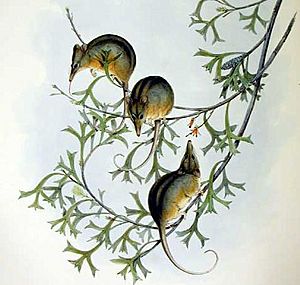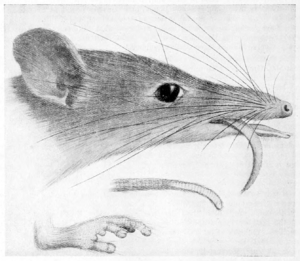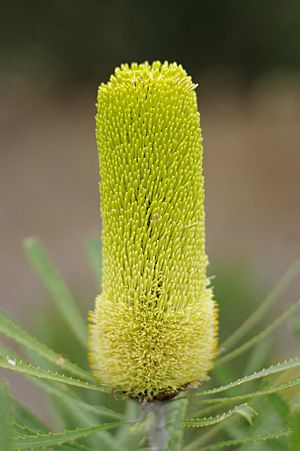Honey possum facts for kids
Quick facts for kids Honey possum |
|
|---|---|
 |
|
| Conservation status | |
| Scientific classification | |
| Genus: |
Tarsipes
|
| Species: |
rostratus
|
 |
|
| Honey possum range | |
| Synonyms | |
|
|
The honey possum, also called noolbenger, is a tiny marsupial. Its scientific name is Tarsipes rostratus. This small animal loves to eat nectar and pollen from many different flowering plants.
You can find honey possums in southwest Australia. They are very important for helping plants like Banksia attenuata, Banksia coccinea, and Adenanthos cuneatus make seeds. This process is called pollination.
Contents
About the Honey Possum Family
The honey possum was first described by scientists Paul Gervais and Jules Verreaux in 1842. They studied a specimen collected near the Swan River Colony in Australia.
The honey possum is the only known species in its group, called Tarsipes. It belongs to a special family called Tarsipedidae. The name Tarsipes means "tarsier-foot." This is because its feet and toes look a bit like those of a tarsier, which is a small primate.
Scientists used to think the honey possum was related to a small marsupial from South America, the Dromiciops gliroides. However, newer studies show this is not true. The honey possum's closest relatives are other Australian possums and gliders.
Honey Possum's Relatives
The honey possum is part of a larger group of marsupials called Diprotodontia. Here are some of its relatives:
- Superfamily Petauroidea
- Family Pseudocheiridae (ringtail possums)
- Family Petauridae (gliders and trioks)
- Family Tarsipedidae (honey possums)
- Genus Tarsipes
- Tarsipes rostratus
- Genus Tarsipes
- Family Acrobatidae (gliders)
The Noongar people, who are the traditional owners of the land where honey possums live, have several names for this animal. Some of these names are ngoolboongoor, djebin, and dat. Another common name is "honey mouse."
What Does a Honey Possum Look Like?
The honey possum is a very small marsupial. It climbs woody plants to find pollen and nectar. It looks a bit like a small mouse or other Australian possums. You can easily spot it because of its very long nose and three brown stripes on its back. These stripes run from its head to its bottom.
Its fur is creamy white underneath and turns reddish-brown on its sides. The fur on its upper body is a mix of brown and grey hairs. A dark brown stripe goes down the middle of its back. There are two lighter stripes next to it.
The honey possum's tail is long, about 70 to 100 millimeters (2.7 to 3.9 inches). This is longer than its body and head combined, which are 65 to 85 millimeters (2.5 to 3.3 inches). Its tail can grip things, helping it climb. Honey possums weigh between 5 and 10 grams (0.17 to 0.35 ounces).
Special Mouth and Tongue
Honey possums have fewer teeth than most marsupials, and their teeth are very small. Their molars (back teeth) are tiny cones. This is because they don't chew their food much.
Their long snout and special teeth help them eat nectar and pollen. The honey possum's tongue can stretch out and has a brush-like tip. This brush helps it collect pollen and nectar. Its lower front teeth and a special part of its mouth also help with this.
Honey possums have excellent eyesight. This helps them find bright yellow flowers, like those of Banksia attenuata. They usually live for one to two years.
Honey Possum Behaviour
Honey possums are mostly active at night. However, they might come out to feed during the day if the weather is cool. During the day, they usually sleep in a safe spot. This could be a crack in a rock, a hollow in a tree, inside a grass tree, or an old bird's nest.
When there isn't much food, or when it's cold, honey possums can go into a state called torpor. This helps them save energy. Their body temperature and metabolism are usually quite high. But in torpor, they can lower their body temperature. This is similar to how some other small marsupials save energy.
Climbing and Feeding
Honey possums are great climbers. They use their gripping tail and a special first toe on their back foot. This toe can grab things like a monkey's paw. The brush-like tip of their tongue helps them quickly wipe up pollen and nectar from flowers.
Both their front and back feet are good at grasping. This allows them to climb trees easily and move quickly through thick plants. Their tail is longer than their body and head combined, and they can use it like an extra arm to hold on.
Scientists have used radio-tracking to study honey possums. Male honey possums can travel up to 0.5 kilometers (0.3 miles) in one night. They use an area of about 0.8 hectares (2 acres). Some males travel even further. Pollen found on one honey possum came from a plant over three kilometers away!
Honey possums get nectar and pollen from many plants. These include Banksia and Adenanthos (from the Proteaceae family), eucalypts and Agonis (from the Myrtaceae family), and heath plants (from the Ericaceae family). They also visit Anigozanthos (kangaroo paws) and Xanthorrhoea (grass-trees).
A honey possum weighing nine grams needs about seven milliliters of nectar and one gram of pollen every day. This amount of pollen gives them enough protein for their active lifestyle. Female honey possums, especially when feeding their babies, get extra protein from Banksia pollen.
Honey possums can drink a lot of water when feeding on wet flowers. Their kidneys are very good at processing this extra water. They can handle up to twice their body weight in water! They digest pollen grains in about six hours, getting almost all the nutrients from them.
Honey Possum Life Cycle
Honey possums can breed at any time of the year. This depends on when there is enough nectar available.
A female honey possum is pregnant for 28 days. She usually gives birth to two to four tiny babies. At birth, these babies are the smallest of any mammal, weighing only 0.005 grams (0.00017 ounces).
The babies stay in their mother's pouch for about 60 days. When they come out, they have fur and their eyes are open. They weigh about 2.5 grams (0.08 ounces). At first, the mother might leave them in a safe spot, like a tree hollow, while she looks for food. But soon, the babies learn to hold onto her back and travel with her.
They stop drinking milk around 11 weeks old and soon after, they start to find their own homes. Often, a mother will have another litter of babies right after the first ones leave her pouch.
Outside of the breeding season, honey possums usually live alone in their own areas, which are about one hectare (2.5 acres) in size. They live in small groups of up to 10, but they rarely fight each other. During breeding season, females move into smaller areas with their young. They will protect these areas strongly, especially from males.
Where Do Honey Possums Live?
Honey possums live in a fairly small area in the southwest of Western Australia. They are quite common in these areas. They are not currently threatened with extinction, as long as their homes remain safe. Their habitat includes heathlands, shrublands, and woodlands.
Records show that honey possums are more common in places with many different types of Proteaceae plants. These are areas like banksia woodlands, where different plant species flower all year round. This ensures a constant food supply for the honey possums.
Honey Possum's Role in Nature
The honey possum is a keystone species in the coastal sandy areas of Southwest Australia. This means it plays a very important role in its ecosystem, called kwongan. Honey possums are likely the main pollinators for woody shrubs like banksia and Adenanthos.
When they feed, they visit many different plants. Their heads carry a small amount of pollen, which they can spread more effectively than birds that visit the same flowers. The plant Banksia attenuata seems to rely on the honey possum for pollination. Both the honey possum and this plant have evolved to help each other. This is called a mutualistic relationship.
Scientists have studied how fires affect honey possum populations. They found that honey possums can recover from fires. However, more frequent and intense fires, possibly due to climate change or prescribed burns, could harm their habitat.
Honey possums are also at risk from a plant disease caused by Phytophthora cinnamomi. This fungal-like species causes forest dieback in eucalypt forests and banksia woodlands. The honey possum relies on nine plant species for food all year. Five of these are vulnerable to this disease.
The honey possum is the only mammal on land that eats only nectar. It has a long, pointed snout and a long tongue with a brush tip. This helps it gather pollen and nectar, much like a honeyeater bird or a hummingbird. Having many different types of flowers is very important for the honey possum. It needs a year-round supply of nectar. Unlike birds, it cannot easily travel long distances to find new food sources.
Honey Possum History
The honey possum was well known to the Noongar people of southwest Australia. It was part of their culture. The Noongar name ngoolboongoor has been suggested for modern use as a common name. Honey possums are still an important animal to the people of this region. An artist named Amok Island even featured the honey possum in a large public art project on silos.
The first scientific report of the species was put together by John Gilbert. He was a careful field collector hired by scientist John Gould. Gilbert traveled to the Swan River Colony in Western Australia. He learned from Noongar people about the animal's habits and names. He also collected four specimens for scientific study. Both Gilbert and Gould realized how unique this new species was.
Later, another scientist named Ellis Troughton studied the honey possum. He visited King George Sound and eventually got a collection of a dozen specimens. These had been gathered over many years by cats from a place called Nannarup.
More studies of honey possums in captivity began in 1974. This allowed scientists to learn more about their reproduction. A big study in the Fitzgerald River National Park in 1984 helped scientists understand their population and feeding habits better.
Eating only nectar is very unusual for a land mammal. This special way of life for the honey possum developed about forty million years ago. It adapted to feed on the successful plant families like Proteaceae and Myrtaceae.
See also
 In Spanish: Falangero mielero para niños
In Spanish: Falangero mielero para niños




